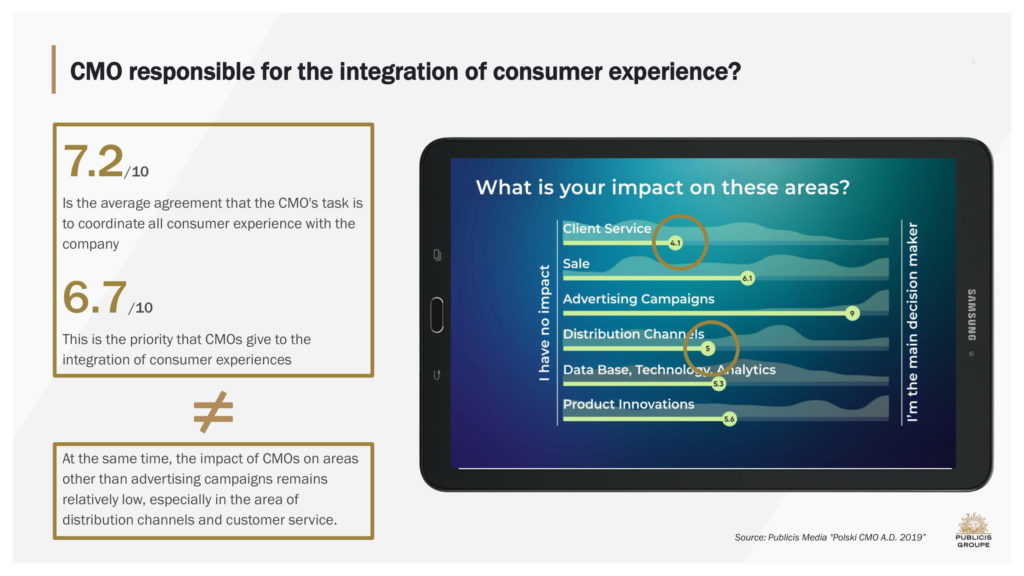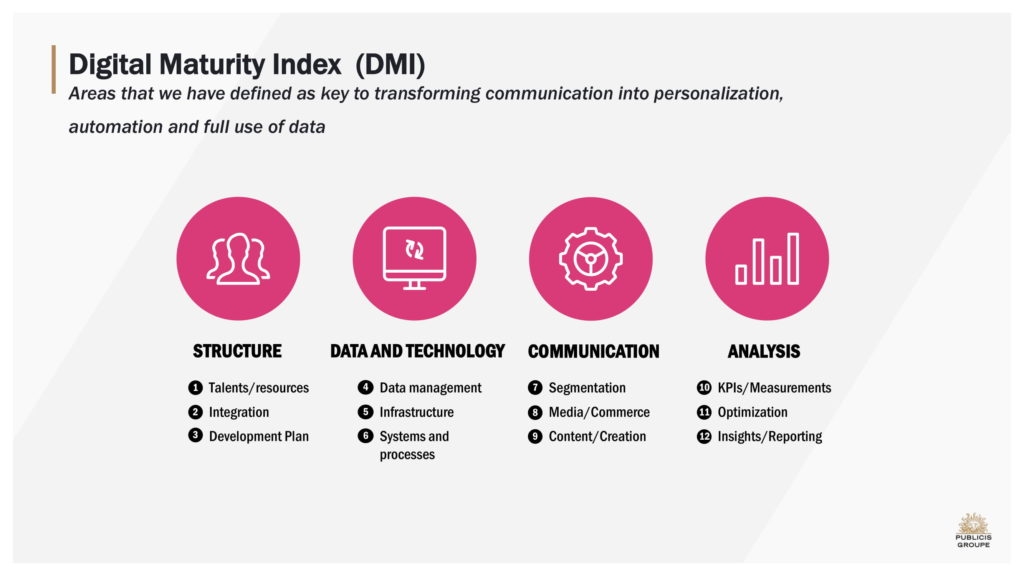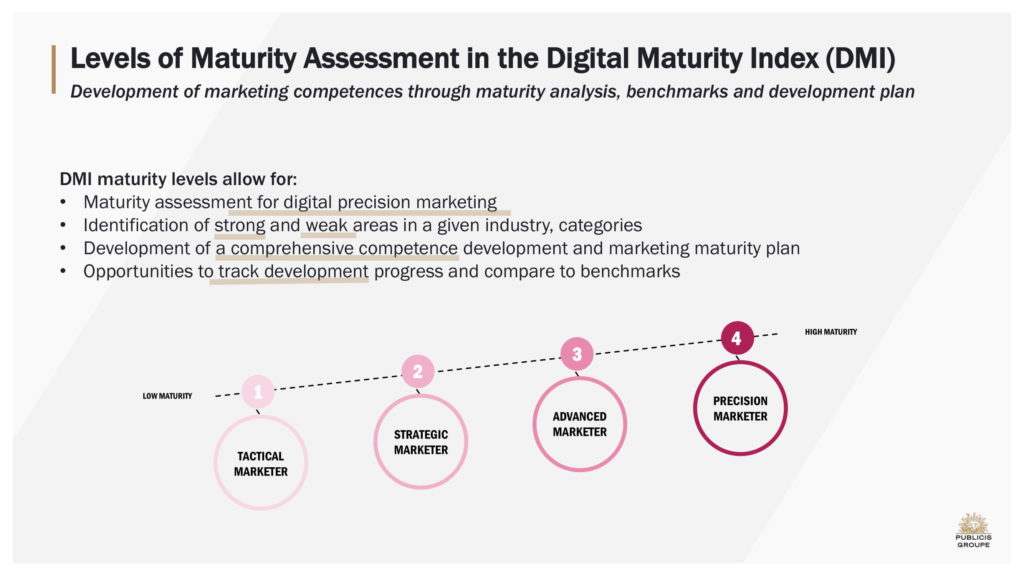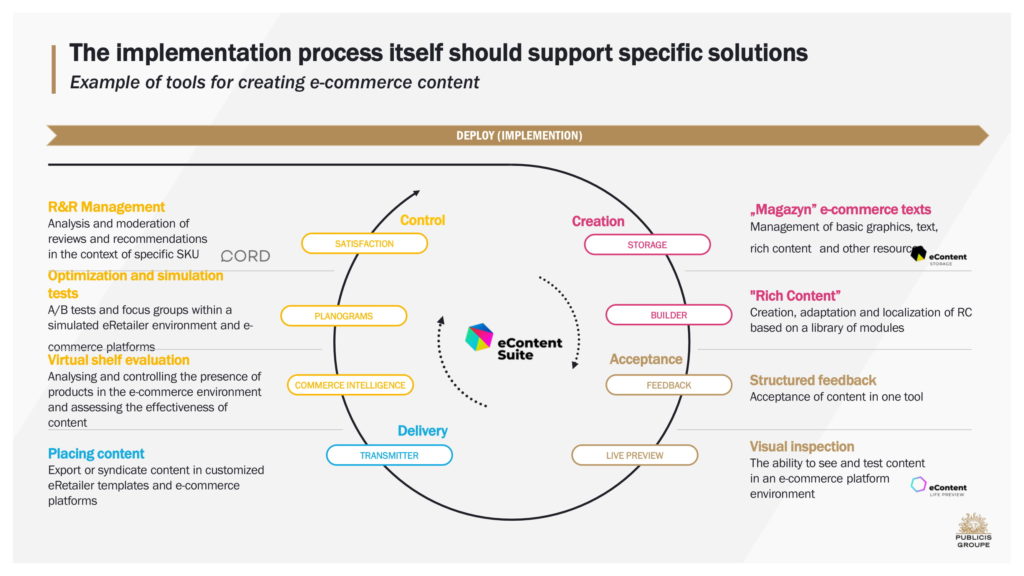The Publicis Groupe Manifesto, implemented on a daily basis by all the Agencies that make up our organization, sets a key direction for all our activities: we handle the designing of engaging experiences for people along the entire path of contact with brands.
In this approach, marketing plays a leading role in building brand value, which in turn translates directly into generating additional revenue for companies. Moreover, such a Vision makes causes marketing to have a significant impact on people/consumers through its actions, and also has the opportunity to play the key role in taking advantage of the digital transformation and transferring its effects to business.
I have been describing how the role and position of CMOs is changing and what great opportunities stand before innovatively thinking marketing managers for several years now. The clear direction is to represent marketing on the company’s management board and actually become a “right hand” to the CEO. Those who, thanks to their competences and responsibilities, which cover the key growth-generating areas of the company, are the important partners in discussions about the business and its future for the CEO.
The research we conducted in 2019, which was based both on a dozen or so in-depth interviews with marketing managers and whose theses we verified in the quantitative study, clearly shows that the priority of a CMO is “building business growth” – an average indicator of 8.3 on a scale of 1-10. The responsibility for “integration of the consumer experience” was also high 7.2 / 10. On the other hand, it is worth noting that, according to our respondents, the impact of CMOs on areas other than “implementation of advertising campaigns” (9.0 / 10), especially in the area of distribution channels and customer service, remains relatively low.

The same discrepancy was noted in the area of influence and responsibility of CMOs for the use of data in the organization. CMOs believe they should oversee all areas related to consumer path analysis (7.6 / 10), but only less than half of them declare that they have any influence on the choice of analytical technologies in their enterprises. Finally, CMOs consider the impact on innovation in a company as one of their priorities (6.3 / 10), but realistically they consider that their activity in the sphere of innovation is still rather wishful thinking.
After a detailed analysis of the conclusions of this study, discussions with our colleagues from the most advanced markets and on the basis of cooperation with Google – one of the technology leaders, we have identified five areas and competences which a modern CMO should develop in, namely:
Digital and precision marketing – meaning, CMOs as Chief Digital Officers in their companies.
Data and analytics – the CMO as a Chief Data Officer.
Improving and making consumer experience more consistent along the way – a CMO as Chief Experience Officer.
Effective introduction and management of the digital sales channel – CMO as Chief Commerce Officer.
Development of consumer-focused innovation and consumer experience – CMO as Chief Innovation Officer.
Just naming these areas and indicating how important they are is not enough. At one point, I realized that it was crucial to prepare a specific plan to measure the level of sophistication and maturity of a particular client’s company at a particular point in time. How it looks compared to others from the same or similar industry, how it looks compared to similar companies from other parts of the world, finally allows it to establish where it wants to be and at what time.
Therefore, we have created a set of 5 Programs supporting the development of competences of a modern CMO. As in the case of creating an excellent training plan, in each case we define the following at the beginning of the project: What do we want to do? What do we want to achieve? What do we want to measure?
For example, in the area of “Development in the organization of digital and precision marketing”, also called Digital Maturity, we had to define the key fields that we defined as the most important for transforming communication into personalization, automation and full use of data. These were collected in four categories:
Structure, consisting of the company’s available talent and human resources, internal integration, or the actual disintegration of teams, for example, by separating them into closed departments that are reluctant to work together, and the adopted policy for future competence building (referred to here as the Development Plan).
Data and Technology, which includes the way data is managed, the infrastructure that you have, as well as the systems and processes available. Of course, it happens quite often nowadays that even having systems, often expensive, does not mean their skillful and full use. Suffice it to say that in many of the companies we talk to, the use of implemented systems in the field of Marketing Automation is estimated at 5-10 % of their capabilities. And what companies actually pay the invoices for every month.
Communication, which includes the evaluation of the number of recipient segments and matching messages to them, coherence or a complete lack of it in the areas of ATL communication and commerce channel, as well as analysis of coherence and mutual support/ consistency of messages.
Activity analysis with different KPIs – very often a single measurements is used – mostly cost or outreach – to assess the effectiveness of activities. In addition, the frequency of measurements, the quality of optimizations and the use of insights and lessons learned from the past to build a Learning Agenda are assessed, and finally, whether reporting is manual and time consuming or whether fully automated dashboards are used, which are still properly designed to facilitate learning and build more effective scenarios in the future.

A thorough analysis of the above mentioned categories allows for a fairly objective and comparable assessment of the organization’s maturity in this area. The company has a chance to check which stage of development it is currently in, at the same time it can determine its strengths and weaknesses, both its own, as well as those of a given industry or the entire category.
The final result also allows a comprehensive competence development plan to be elaborated and translated into a schedule of specific actions, and , last but not least, it provides an opportunity to track the progress of development and compare it to external benchmarks.
After all, nothing is as motivating to further work as much as awareness of the goal and the possibility to check the effects of the changes.

The second extremely important element, which we have worked out after defining exactly what we want to do/achieve/measure, is to answer the question how this will be done.
In other words, in which modules should the transformation process be implemented in order to achieve the best and expected results in the shortest possible time. The answer to this question is to introduce three main stages to each program.
In the first stage, called Discovery, we allow for self-assessment of the organization’s maturity in a given Program by answering a prepared questionnaire. Of course, it is possible to further deepen the knowledge with the use of diagnostic workshops and interviews. We know from experience that workshops are often the first opportunity to bring together all the participants (stakeholders) of the process, who have not even talked to each other before, for various reasons. If the process is conducted skilfully and given the appropriate priority by the company’s management, there is a clear willingness to solve problems together and move forward at this stage. This stage also serves to define the desired state to which we are heading, which in effect leads to a clear picture of the “gap” to be filled.
The second stage is the strategic phase (Design), during which we present how the specific conclusions of the audit are transformed into strategic initiatives and projects to improve the area. Sometimes there are so many ideas on the list that you need to be able to define the most important ones and clearly define priorities. All this for clarity of action and to arrange it into a strategically sequential feasibility study. Without such an approach there would be chaos and a multitude of duties within the teams, which could be lethal for the project itself, and would certainly significantly slow it down and reduce the motivation for its timely implementation.
In the third stage – Implementation – we supervise the implementation of the detailed work schedule. We check whether all the elements of the roadmap are implemented on time and, in the case of congestion, we signal the threats to the level of the company’s Management Board in time to remove unexpected obstacles or correct the schedule. This allows the dynamics of work and motivation in project teams to be maintained. This stage also serves to summarize the effects of the introduced implementations and report them to the Management Board.
Finally, the third element closing the Company’s Maturity Development Program in a given area is answering the questions, HOW can we help ourselves in faster completion and implementation of the Strategy described above.
In other words, what technologies can help us to implement the plan more effectively, what tools can we use for this purpose and what external partners can speed up the entire process. In each of the five Programs, the set of the above “Accelerators” is different, but we offer the most advanced solutions in the Commerce Excellence Framework.

One of the tools used is the eContent Suite platform, which helps to manage both the stage of building and creating content (Product Cards to be placed in e-retailers and marketplaces), but also their storage, or actually efficient management of the repository of graphics, texts and rich content. eContent Suite also helps to achieve quick acceptance in a process without e-mail exchanges (acceptance takes place on the platform itself), automatic sending of materials in appropriate formats accepted by retailers and full optimization and control of the presence of products in a given store or marketplace environment.
The latest eContent Suite module is CORD, which allows reviews and recommendations (Ratings & Reviews) for each product placed in a digital store to be analysed. This module can also be used to collect feedbacks about the product, about consumer experience with the product itself, or for example with packaging (difficulty to open), difficulty in understanding the user manual, but it can also be a source of insight for further product improvement. The potential that is currently totally untapped is at your fingertips.
I hope that I have given you at least a little bit more insight into the areas and competences in which a modern marketer must invest. At the same time, I am sure that only a systematic approach to these areas will allow you to increase the level of maturity of your company in each of them.
And we are available to be your Partner on this path.
I invite you to cooperate with us!
The text is a detailed discussion of the presentation, which was created for the CMO SUMMIT 2020 conference.

